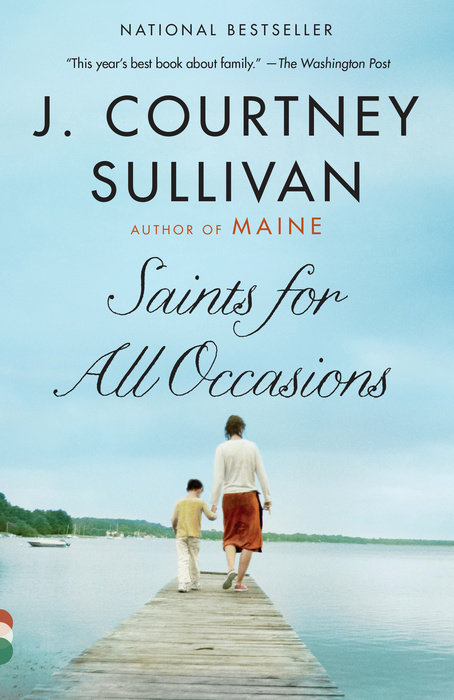
SAINTS FOR ALL OCCASIONS
A sweeping, unforgettable novel from The New York Times best-selling author of Maine, about the hope, sacrifice, and love between two sisters and the secret that drives them apart.
Nora and Theresa Flynn are twenty-one and seventeen when they leave their small village in Ireland and journey to America. Nora is the responsible sister; she’s shy and serious and engaged to a man she isn’t sure that she loves. Theresa is gregarious; she is thrilled by their new life in Boston and besotted with the fashionable dresses and dance halls on Dudley Street.
A sweeping, unforgettable novel from The New York Times best-selling author of Maine, about the hope, sacrifice, and love between two sisters and the secret that drives them apart.
Nora and Theresa Flynn are twenty-one and seventeen when they leave their small village in Ireland and journey to America. Nora is the responsible sister; she’s shy and serious and engaged to a man she isn’t sure that she loves. Theresa is gregarious; she is thrilled by their new life in Boston and besotted with the fashionable dresses and dance halls on Dudley Street. But when Theresa ends up pregnant, Nora is forced to come up with a plan—a decision with repercussions they are both far too young to understand.
Fifty years later, Nora is the matriarch of a big Catholic family with four grown children: John, a successful, if opportunistic, political consultant; Bridget, quietly preparing to have a baby with her girlfriend; Brian, at loose ends after a failed baseball career; and Patrick, Nora’s favorite, the beautiful boy who gives her no end of heartache.
Estranged from her sister, Theresa is a cloistered nun, living in an abbey in rural Vermont. Until, after decades of silence, a sudden death forces Nora and Theresa to confront the choices they made so long ago. A graceful, supremely moving novel from one of our most beloved writers, Saints for All Occasions explores the fascinating, funny, and sometimes achingly sad ways a secret at the heart of one family both breaks them and binds them together.
- Vintage
- Paperback
- May 2018
- 432 Pages
- 9780307949806
About J. Courtney Sullivan
 J. Courtney Sullivan is the New York Times best-selling author of the novels The Engagements, one of People magazine’s Top Ten Books of 2013 and an Irish Times Best Book of the Year; Maine, a 2011 Time magazine Best Book of the Year and a Washington Post Notable Book; and Commencement.
J. Courtney Sullivan is the New York Times best-selling author of the novels The Engagements, one of People magazine’s Top Ten Books of 2013 and an Irish Times Best Book of the Year; Maine, a 2011 Time magazine Best Book of the Year and a Washington Post Notable Book; and Commencement.
Praise
A National Best Seller
A New York Times Critics’ Top Book of 2017
Washington Post 10 Best Books of 2017
A Harper’s Bazaar Best Book of 2017
“This year’s best book about family.”—Ron Charles, The Washington Post
“Reminiscent of both Colm Toibin’s Brooklyn and Matthew Thomas’s We Are Not Ourselves… All of Sullivan’s characters leap off the page. You don’t read this book; you breathe it.”—Janet Maslin, “Times Critics’ Top Books of 2017,” The New York Times
Discussion Questions
1. Describe the differences between Nora and Theresa when they were girls. Did you find it surprising how their paths diverged as they grew older?
2. Discuss Nora’s sense of responsibility and obligation to her family, including as the oldest sibling and following her mother’s death. How does this role, which she adopts from a young age, influence her understanding of motherhood throughout her life?
3. Although Patrick is not alive in the present-day sections of the novel (2009), how does the author give us a full portrait of his character? What do others’ opinions and memories of him help us glean about his personality and behaviors that a more direct interaction with him in the narrative wouldn’t provide?
4. How do all of Nora’s children complement one another, even as we see their vastly disparate feelings toward Patrick? What do their reactions Even though a death is at the center of the novel’s plot, did you find that death was a central concern of the novel’s themes? Either way, what does the cascade of events following a death like Patrick’s suggest about how we might value our time with loved ones and the legacy that we leave them with when we’re gone?
5. Even though a death is at the center of the novel’s plot, did you find that death was a central concern of the novel’s themes? Either way, what does the cascade of events following a death like Patrick’s suggest about how we might value our time with loved ones and the legacy that we leave them with when we’re gone?
6. Discuss the portrayal of romantic love in the novel: between Nora and Charlie, Bridget and Natalie, John and Julia, and other couples. How is it prioritized differently among them, and what are the particular ways that affection and passion manifest themselves between couples?
7. How does Mother Cecilia’s experience in the abbey compare with your expectations of what religious life is like? Were you surprised by any of the stances she took toward the church, other nuns and priests, and changes in culture during the novel’s time period of the late 1950s through 2009?
8. What seem to be the biggest differences between the girls’ lives in Ireland and their lives in the United States? Did you feel that either of them regretted the move at any given point, and why?
9. Describe the shifting gender dynamics over the course of the novel’s timeline. In the roughly fifty years that pass, what changes about men’s and women’s roles and what doesn’t, including to the roles influenced by the family’s deep, traditional Irish roots?
10. How do Nora and Theresa respond differently to the task of motherhood that falls upon them, biologically or otherwise? In what ways are they both mothers to Patrick and the other people in their lives? How does the novel upend the traditional definition of motherhood, which Nora describes as “a physical act as much as an emotional one. It took every part of you” (page 229)?
11. How did the structure of the novel influence your understanding of and sympathy toward the characters as the narrative moved back and forth in time? What was the benefit of learning about Patrick, in particular, in this way—seeing him first in a posthumous light and then more closely as he grew up? And how did the perspective on the family that you had as a reader differ from what the characters could know about themselves and one another in real time?
12. What were common threads among the secrets the characters kept from one another? Why do you think some characters, more than others, were more willing to be complicit in keeping those secrets, especially when it came to Patrick?
13. How do you think the circumstances of Patrick’s birth affected his sense of belonging, even if only implicitly? What other characters struggled to feel like they belonged, and how did they deal with those feelings?
14. Early in the novel, Theresa is described as “simply the most. The most brave and beautiful and brash and clever” (page 15). How does this quality help her stay resilient through the many obstacles in her life? How do other characters, including Nora, prove to be resilient in their own ways, and which characters are most successful?
15. What did you make of the end of the novel? Do you think that the sisters will be able to truly forgive each other, or is their past too much to overcome?
16. Consider your own family relationships and customs, including religious beliefs and traditions. Were there parts of the Raffertys’ rituals or conflicts among one another that seemed familiar to you, even if they weren’t specific to being Irish and/or Catholic?
